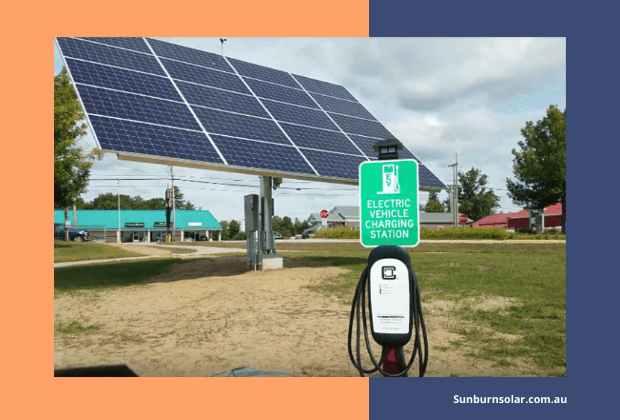Blog
 May31
May31
Solar EV Charging: Facts You Need To Know
Electric vehicles, or EVs, as of now, make up a small proportion of all vehicles sold all over the world. However, EV adoption is predicted to rise this decade, with major manufacturers presently developing electric cars and plug-in hybrids (PHEVs). Numerous drivers are now considering an EV for their next vehicle purchase, although concerns regarding cost, charging, and distance worries are holding them back. Thankfully, with EV prices lowering and the advantage of low maintenance and running costs compared to traditional diesel and petrol vehicles, electric vehicles have become far more enticing to ordinary buyers, especially those with rooftop solar.
The ability to charge an EV is one of the most interesting aspects of a rooftop solar panels installation. Recharging an EV with solar-generated power of your own can effectively wipe away the EV’s ‘fuel’ expense. However, it isn’t always as straightforward as it looks.
So, in this article, we’ll go through the essential information you’ll need to travel on your EV for free, powered by solar energy.
Battery Capacity Of Electric Vehicle
Before diving into the various insights relating to solar EV charging, it’s important to learn about the capacity and range of electric vehicles. The capacity of a Solar EV battery is expressed in kilowatt-hours (kWh), and EVs come with batteries ranging in size from 24kWh to 100kWh or even more. The majority of electric vehicles come with a battery capacity of around 65 kWh, which offers a range of almost 350 kilometers depending on driving circumstances and efficiency. Electric Vehicles that are lighter and more efficient can have a battery consumption of as low as 12kWh for every 100km (1kWh = 8.2km), whereas bigger, high-performance EVs might consume 20kWh or even more for each 100km (1kWh = 5km).
Because of the enhanced aerodynamic drag, driving at greater speeds reduces driving range. Most electric vehicles, however, incorporate regenerative braking, which restores plenty of the energy lost when the vehicle is slowed by braking. Regenerative braking is especially useful in city driving since it improves the economy while simultaneously reducing brake dust and pollutants.
Read More Blog – Everything you need to know about going green with Solar Battery
Partial Charging Is More Realistic
In the majority of cases, charging the EV battery daily to its full capacity is unrealistic. This is due to the fact that the solar panel installation that you’d require will be far too large.
This is why:
- A 25kW solar panel system (containing approximately 64 panels) is required to completely charge a Tesla Model X (100kWh battery).
- A 10kW solar panel system (containing approximately 26 panels) is required to completely charge a Nissan Leaf (40kWh battery).
- In each situation, there would be insufficient solar energy to meet your household’s electrical needs.
While a 15kW solar panel system may indeed be sufficient to completely charge a Nissan Leaf as well as meet your household’s electrical demands, it is likely inadequate. It also wouldn’t be powerful enough to recharge the battery during overnight EV charging.
Therefore, it’s more feasible to concentrate on partial everyday charging than trying to set up enough solar panels to completely charge your EV.
You won’t need a gigantic home with a lot of roof space to accommodate so many solar panels!
How Much Additional Solar Will I Require?
This is dependent on your EV’s battery capacity, its range, the distance you commute on a daily basis, and the number of hours of ideal sunlight.
To skip to the main point, the total amount of sunlight required to cover a daily trip of 100 kilometers is roughly:
2 kWh for perhaps a Nissan Leaf, and 6 kWh charge a Tesla Model X.
It is possible to increase the size of your solar panel installation by 2kW or even 6kW. It’s also a lot less expensive than trying to set up adequate solar panels to completely charge your electric vehicle every day.
How Much Time Does It Take To Charge An EV Using Solar Power?
The solar system’s size, as well as the battery capacity of EV, are the two most important factors in this subject. Using a normal 6.5kW rooftop solar system, charging a standard electric vehicle from 20 to 80 percent will take a prolonged sunny day. When we talk about EV charging at home, the more the sunlight, the better it is, particularly in chilly, less sunny climates. EV charging through rooftop solar will be reasonably simple, utilizing a normal rooftop solar system assuming you are home during the day.
The time required to power an electric vehicle is determined on the battery health, the charger utilized, and the atmospheric conditions. On a bright day, a bigger 10kW rooftop solar system combined with the more efficient 7kW Type 2 charger is capable enough to charge an EV nearly to 80% in roughly 6 hours, whereas a more robust 3-phase charger paired with a 15kW solar system could fuel an EV up to 80% within a limited period of 4 hours. However, do note that the majority of these charging periods assume that there is little home load and primarily bright weather; nevertheless, things aren’t always perfect in actuality. Here is the role of a smart EV charger if you are looking forward to avoiding having to pay for grid electricity in order to charge your EV at home.
Read More Blog – Why Is It A Good Idea To Get Solar On Finance?
Prepare To Charge Your EV At Home With Solar
If you have any queries about the optimal size solar system for charging your EV and meeting your home energy demands, contact Sunburn Solar today. Our solar experts will understand your EV and home energy usage requirements and crunch the statistics for you. The optimal size of solar panels installation in Melbourne to match your demands as well as budget will then be recommended.
© 2025 sunburnsolar.com.au. All rights reserved.

